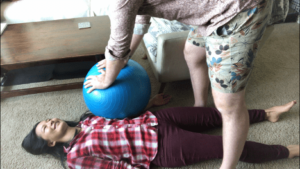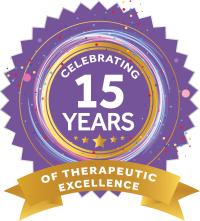 In this E-Therapy Voices blog post, Occupational Therapist Jasmine JJ Erazmus explains the benefits of using Deep Pressure Touch Sensory Activities to help children calm down and relax.
In this E-Therapy Voices blog post, Occupational Therapist Jasmine JJ Erazmus explains the benefits of using Deep Pressure Touch Sensory Activities to help children calm down and relax.
How to Use Deep Pressure Touch Sensory Activities to Boost Attention During Virtual School
by Jasmine JJ Erazmus OTR/L
This week one of my students started our virtual Occupational Therapy (OT) session in tears. He was overwhelmed in class right before our session. We started with 2 minutes of silence with a timer which helped to de-escalate his emotions. He enjoyed a long hug with his mom and said, “I have an idea!” He suggested that he get deep pressure touch in the form of pillow “squishes” like he did in the last session. After 15-20 minutes of these activities and a few minutes under a weighted blanket he was drawing and then writing. At the end of the session he interrupted before I closed our meeting. His voice was still shaky from the crying earlier.
He said, “Jasmine, thank you for helping me.”
The feeling in my heart from his sincere gratitude is the reason why this is the topic of this E-Therapy blog post. That student is on the autism spectrum but these techniques are ones I suggest for any child without physical injuries. For everyone working with a child with a goal such as “(student) will pick a sensory strategy with (level of assistance) and return to attending to an academic task after (X number) minutes,” the activities below will add a few more to your list of strategies that can get a kid ready to learn and participate in therapy or school.
Deep Pressure Touch
The topic of today is deep pressure touch (DPT). This touch is applied with increased pressure. Examples include gentle squeezes, compressions, or hugs. Deep pressure touch is one of the most commonly used sensory tools in the OT toolbox. This touch releases serotonin, dopamine, and oxytocin [1],[2]. Deep pressure touch is one of the fastest ways to regulate a child’s nervous system. Having a happy nervous system is the foundation for attention. Oxytocin decreases cortisol (stress hormone) levels. Other benefits include a more regular pulse [1]. Serotonin and dopamine have short and long-term effects to regulate mood, movement, and impulse control. These in addition to oxytocin are released in touch therapy techniques like massage that involve “low to moderate pressure” touch. [2] Another benefit from deep pressure touch is that it increases body awareness or proprioception. This means that our children’s nervous systems can better relax and attend to class because the body is more connected to the brain. Increased proprioception or body awareness in space makes it easier to sit still and perform skilled movements such writing. In summary, the two benefits of deep pressure touch are:
- Relaxed state– releasing feel good hormones
- Body awareness -for attention and skilled movement
Self-directed touch
The most tolerable kind of touch is self-directed. The child is using their own movements to control the intensity of the input, for example, having a child crash into something or hug a pillow. Pillows do not move and are more predictable, so they work well even if a child is in a state of distress or is not a big fan of hugs from others. These activities are a great introduction to deep pressure touch on their terms.
Pillow Crash
Make a BIG pile of pillows and couch cushions on a couch or if you have couch cushions you can put them on the floor. Put them on a yoga mat if on a hardwood floor to prevent the pillows from sliding away and make the ground softer.Simply moving the pillows is already giving deep pressure touch input.
- Have a child “crash” or jump on to the pile
- Count the number of times and determine the number target to help with transitioning out of the activity
Pillow Hugs

- Get a big pillow
- Have a child hug – either from above or lying on their back with pillow on their torso
- One game to play is “Don’t let go”. The child lies on their back and grips a big pillow tightly with their arms and legs wrapped around it. Someone else tries (dramatically) to pull it away from them. I usually cheer the child on, “Don’t let go!!!”
This game also has core strengthening and reflex integration benefits. Working core strength helps with sitting attention – the more stable their base the longer they can attend without a movement break. Reflex integration of the Moro reflex helps a child get out of flight and fight states. This is achieved if their head is tilted back when playing the “Don’t let go game.”
Pillow or Ball Squish
 The child lies on the carpeted ground/couch/yoga mat (something soft).
The child lies on the carpeted ground/couch/yoga mat (something soft).
- Use a big Yoga ball or big pillow to SLOWLY press on their lower legs. Check in right when they get the pressure as to how it feels.
- Have the adult roll the ball up their legs (be gentle around knees), keep checking in around pressure and where to “squish”
- Go lightly over their chest if they request the squish over their torso
- You can have them cover their face with their hands if they want you to roll over their head
Manual Deep Pressure Touch
For children that actively enjoy deep pressure touch, they may like deep pressure touch applied manually. A few of the kids I work with often ask for this technique without prompting.
Compressions
 Compressions are easily performed when a child is lying down on their back or belly.
Compressions are easily performed when a child is lying down on their back or belly.
- Have an adult use both hands to push slowly on their limbs into whatever surface they are lying on.
- The key word is SLOW. Have them start soft. I say it is like “pressing into a bag of marshmallows”. This is to make sure you don’t overdo it as it may take a while for a child’s body to register the pressure.
- Hold it there for a slow count of 7-10 seconds and ask how it feels. Dr. Masgutova, a well known therapist practitioner and teacher, recommends 7 seconds for the similar deep pressure technique of embracing squeezes. After taking one of the classes in her program, I began to slow down with my compressions.
You can tell if they are smiling or have their eyes closed with a blissful look on their face that they like it. I find that taking a deep breath helps me connect to myself first before working on others. If you are working with a parent, cue them to breathe and go slowly while doing this technique. If your child prefers a faster pace that is also OK! Just ask. When you check in you teach a child to connect with their body.To do this technique while a child is sitting, you can use the table or desk they are sitting at or have them lie down on the table. Lying down is easiest because you always have a surface to push their body into.Start further from the body on each limb and move closer towards the center of the body with hands squeezing hips together on legs after the top of the knees.
Compressions at a table with chair
- Have an adult push their forearms onto the table.
- Make sure the adult keeps their hands soft and forming to the shape of the arm.
- On the legs you can have an adult use two hands to wrap around the calves to start.
- Moving closer to the core, they can push the child’s lower thighs into the chair. Pressure can also be applied at the outer hips with two hands.
- Instead of someone using hand strength have them push from their core, leaning in gently. It will feel better for everyone.
*You can hold for fewer seconds but the longer you do it the more their nervous system can register where you are for body awareness.Occasionally a child will feel extra (maybe too) relaxed when lying down. Have them sit up and take a few minutes before jumping into the next activity on the schedule. Word of caution: No child or sensory system is the same. When considering introducing something new to your student explain what you will do before doing it. Check in frequently to make sure it feels good. Stop if it doesn’t. And HAVE FUN!
Building Body Awareness
These techniques are NOT a “cure all” to behaviors. You will need to adjust the intensity of pressure and duration. Increased frequency of deep pressure touch over many days will build body awareness over time. Some kids will need many sessions of self-directed deep pressure touch before they will feel safe allowing someone else to apply pressure to them. You can have them switch roles and do these activities on an adult so they can get the pressure from pushing.Once you get going with these remember that most kids enjoy novelty so you can make your own games (think themes: space, pirates, dinosaurs). The pillow can be a big egg that the child must guard against dinosaurs trying to steal it! Check out this blog has many fun ideas for “heavy work” or activities that give deep pressure.These stand-alone activities are akin to sensory “snacks” and if you want a combination of activities that are a part of a “sensory diet,” you can talk with an OT on how to create one. References:1) Field T, Hernandez-Reif M, Diego M, Schanberg S, and Kuhn C. Cortisol Decreases and Serotonin and Dopamine Increase Following Massage Therapy. 2005. Int J Neurosci 115(10):1397-413.http://sitn.hms.harvard.edu/flash/2016/research-into-our-sense-of-touch-leads-to-new-treatments-for-autism/2) Uvnäs-Moberg K, Handlin L, Petersson M. Self-soothing behaviors with particular reference to oxytocin release induced by non-noxious sensory stimulation. Front Psychol. 2015;5:1529. Published 2015 Jan 12. doi:10.3389/fpsyg.2014.01529https://www.ncbi.nlm.nih.gov/pmc/articles/PMC4290532/#B151
